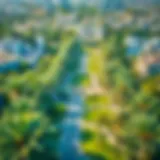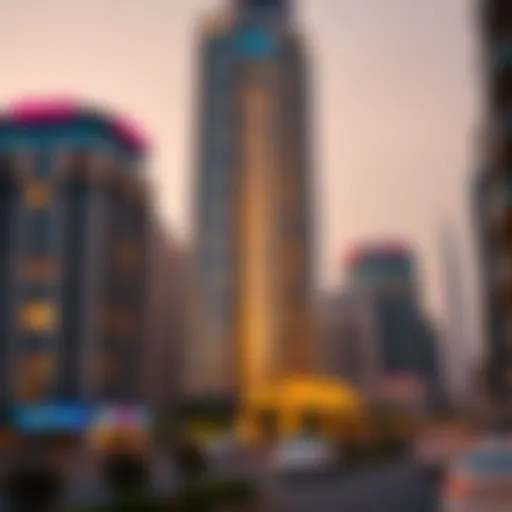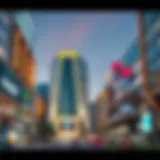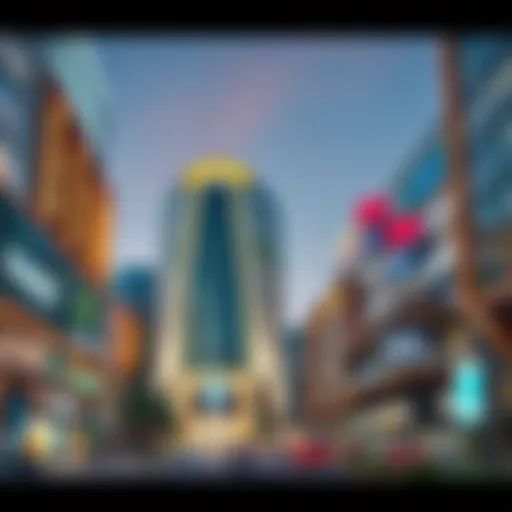Discovering Al Nasr and Oud Metha in Dubai


Intro
Nestled within the vibrant heart of Dubai, Al Nasr and Oud Metha stand out not just as neighborhoods but as living stories woven into the city's fabric. Each area holds its unique identity, shaped by history, culture, and modern trends that appeal to both residents and those merely passing through. Al Nasr is celebrated for its bustling markets and local eateries, while Oud Metha is synonymous with lush parks and a quieter pace. In this article, we’ll unravel the layers of these intriguing neighborhoods, revealing the distinctions and similarities that make them vital parts of Dubai's urban landscape.
Neighborhood Features
Landscaping Highlights
The landscaping in Al Nasr and Oud Metha reflects a thoughtful blend of nature and urban design. Al Nasr, with its wide-deserted streets, is adorned with palm trees and vibrant flowering plants that add vibrancy to the environment. The parks here, like Al Nasr Park, feature spacious green areas that invite families and fitness enthusiasts alike to enjoy outdoor activities.
Conversely, Oud Metha boasts a more structured landscape with its well-maintained gardens and walking paths. The Dubai Creek Park in this area presents a magnificent opportunity to bask in nature's bounty, featuring beautifully manicured lawns and an array of recreational facilities. Picnicking, jogging, or simply taking a stroll becomes a delightful escape from the urban rush.
Architectural Styles
When it comes to architecture, both neighborhoods reveal a fascinating fusion of traditional and contemporary designs. In Al Nasr, the architecture often carries the essence of Emirati culture while embracing modernity. The buildings showcase intricate facades, with some homes even featuring decorative tiles that echo the region's heritage.
Oud Metha, on the other hand, leans more toward modern residential and commercial spaces, with sleek lines and innovative features. High-rise buildings intermingle with quaint villas, offering a contrast that captures the eye. The Mall of the Emirates stands tall nearby, marking a blend of shopping and architectural prowess, attracting visitors from miles away.
Community Life
Local Events and Activities
The vibrancy of community life is palpable in both Al Nasr and Oud Metha. Al Nasr frequently hosts local markets, where residents gather to taste traditional food, craft, and art. Events such as the Dubai Food Festival often find their way into this area, showcasing a delightful array of culinary talents while fostering a spirit of togetherness.
In Oud Metha, community events focus more on family-friendly activities. Festivals and cultural celebrations, such as Eid Al Fitr, transform parks into lively hubs filled music, dance, and shared joy. The presence of schools and community centers fosters a close-knit atmosphere where children and adults alike engage in various recreational practices.
Lifestyle Amenities
Both neighborhoods are well-equipped with amenities that cater to a diverse population. In Al Nasr, one finds numerous cafes and restaurants, serving everything from Emirati dishes to global cuisines. The local supermarkets and shops provide convenient options for daily needs, ensuring residents enjoy a high standard of living.
Oud Metha matches this with a variety of lifestyle amenities. Whether it's fitness centers, beauty salons, or healthcare facilities, the needs of the community are well met. Schools in the area also offer quality education, reinforcing the community-oriented lifestyle that many families desire.
"Understanding the distinct characteristics of Al Nasr and Oud Metha offers not just a glimpse into Dubai's urban planning, but also an insight into the lives of those who call these neighborhoods home."
As we journey through the details of Al Nasr and Oud Metha, the significance of their features will become increasingly clear, revealing just how these areas contribute to the broader narrative of Dubai.
Preface to Al Nasr and Oud Metha
Al Nasr and Oud Metha are not just mere neighborhoods within the sprawling city of Dubai; they represent a unique fusion of tradition and modernity, cultural richness and urban charm. Understanding these areas is essential for anyone interested in the multifaceted nature of Dubai, which is often perceived through the lens of its glitzy skyscrapers and luxurious lifestyle offerings. By focusing on Al Nasr and Oud Metha, one uncovers the layers of history, community, and evolution that contribute to Dubai’s distinct character.
The Importance of Al Nasr and Oud Metha
These neighborhoods stand as a testament to Dubai's broader narrative, lightly tucked away from the incessant hustle of the more commercial zones while boasting their own array of important features. Al Nasr, with its blend of residential avenues and vibrant local businesses, serves as a hub for family activities and heritage events. Meanwhile, Oud Metha, known for its educational institutions and cultural centers, radiates a sense of intellectual pursuit intertwined with the daily rhythm of city life.
The strategic location of these areas means they provide easy accessibility to some of the city's key attractions, making them appealing for homeowners and tourists alike. Being positioned near prominent sites offers residents the convenience of urban life without sacrificing the charm of community living. Moreover, for planners and architects, these neighborhoods present an intriguing case of successful communal spaces that balance various aspects of urban development.
In a nutshell, Al Nasr and Oud Metha encapsulate what it means to live in a city that is constantly evolving yet remains deeply rooted in its past. This article aims to delve deeply into the characteristics, offerings, and community dynamics of these neighborhoods, providing a comprehensive overview that resonates with those who seek to appreciate the intricacies of Dubai's cultural and social fabric.
"Al Nasr and Oud Metha embody the delicate interplay of history and modernity, showcasing what life in Dubai offers beyond the flashy facade."
Exploring these neighborhoods will not only unveil their unique attributes but also highlight their significance in shaping the overall identity of Dubai. Thus, diving into the particulars of Al Nasr and Oud Metha becomes paramount for anyone looking to gain an in-depth understanding of this vibrant region.
Geographical Context
Understanding the geographical positioning of Al Nasr and Oud Metha is crucial for fully appreciating their unique characteristics and accessibility. The layout of a community can greatly influence not only the quality of life for its inhabitants but also how visitors experience the area. Al Nasr and Oud Metha are strategically situated in Dubai, reflecting the city's rapid urbanization while offering an abundance of local charm.
Location and Accessibility
Al Nasr and Oud Metha are nestled in the heart of Dubai, making them easily accessible from various parts of the city. The neighborhoods are bordered by significant roads that facilitate a smooth influx of residents and tourists alike. The Al Nasr area is primarily linked by routes like Sheikh Zayed Road, a major artery that connects diverse parts of Dubai, while Oud Metha benefits from proximity to Al Rebat Road. Public transport options, including the Dubai Metro, enhance connectivity further with the Oud Metha Metro Station serving as a vital hub, enabling effortless travel across the emirate.
This accessibility plays a crucial role in the daily life of residents, allowing for quick commutes, easier access to workplaces, and ample social opportunities. The ease of travel not only enhances the quality of life but also attracts businesses and leisure activities to the area, resulting in a vibrant community atmosphere.
In summary, the simple act of getting around can significantly affect the overall appeal of a neighborhood. Al Nasr and Oud Metha, with their well-planned infrastructure and convenient access routes, set a solid foundation for an engaged and active community.
Proximity to Major Landmarks
The location of Al Nasr and Oud Metha is also notable for its closeness to various major landmarks in Dubai. Within a short drive or even a brisk walk, residents can access well-known sites such as the Dubai Mall, Dubai Frame, and the historic Dubai Creek. These landmarks are not just sites of interest; they embody the cultural and economic heartbeat of the city.
The proximity to such attractions is beneficial for several reasons:
- Cultural Engagement: Residents have quick access to art galleries, museums, and performance venues that regularly host exhibitions and events which foster cultural appreciation.
- Economic Opportunities: Having major commercial centers nearby creates job opportunities, enhancing the economic vibrancy of Al Nasr and Oud Metha.
- Social Life: Nearby restaurants, cafés, and shopping areas augment the social fabric of the neighborhoods, making it a lively place to live.
- Tourism Boost: The neighborhood benefits from the influx of tourists visiting nearby landmarks, offering local businesses a chance to thrive.
"The essence of a community is often encapsulated in its location and connection to landmarks that resonate with both residents and visitors."
Historical Overview
The Historical Overview of Al Nasr and Oud Metha serves as a cornerstone to understanding the character and identity of these Dubai neighborhoods. It's not just about old buildings or dates; it's about tracing the evolution of a community that has thrived amid a backdrop of rapid urbanization.
In these two areas, history is woven into the fabric of everyday life. Residents benefit from a rich heritage that offers context to the present and illuminates the future. With roots that dig deep into the Emirate’s past, Al Nasr and Oud Metha reflect the dialogue between tradition and modernity. This historical narrative highlights the significance of the neighborhoods in influencing their surroundings, shaping urban landscapes, and creating a sense of belonging.
Formation and Development
Al Nasr and Oud Metha emerged as integral parts of Dubai’s transformation from a modest trading port to a bustling urban center. Initially, Al Nasr was established in the mid-20th century, when Dubai started attracting investment and interest from various entities. The area's development was influenced largely by expatriate populations and local entrepreneurs who sought to cultivate a vibrant, multifaceted community.
As urbanization took hold, developers adapted the landscape to suit both residential and commercial needs. It became evident that mobility and accessibility were key to sustain growth. Oud Metha followed suit around the late 1970s, marked by increased residential projects and the establishment of educational institutions. These neighborhoods have grown to encompass modern amenities while keeping pockets of their rich history alive.
Cultural Significance
Culturally, Al Nasr and Oud Metha hold unparalleled importance. They are home to numerous events and festivities that celebrate both local and regional heritage. Throughout the year, the neighborhoods host a variety of cultural festivals that focus on traditional art, music, and cuisine, all contributing to a unique cultural tapestry.
One cannot overlook the role of local organizations and cultural centers that work toward preserving the legacy of the area. For instance, various community initiatives aim to promote local artists and craft. The stories and anecdotes passed down through generations help create a bond among residents, fostering a collective spirit that resonates throughout the area.
"Cultural significance is not just framed in monuments; it's in day-to-day interactions, shared meals, and laughter."
Significantly, these neighborhoods are points of convergence for diverse populations. With multi-national families calling Al Nasr and Oud Metha home, cultural nuances coalesce in the most remarkable ways. This richness adds to the ethos of Dubai as a cosmopolitan hub, making these areas a microcosm of the city's broader social fabric.
Residential Landscape
The residential landscape of Al Nasr and Oud Metha plays a pivotal role in shaping the fabric of these distinctive neighborhoods. It is not merely about the physical homes; it encompasses the patterns of daily life, community interactions, and the aesthetics that define these areas. Understanding this aspect provides insights into the living experiences available, which is crucial for homeowners, visitors, planners, and architects alike.
Al Nasr and Oud Metha showcase a mosaic of housing styles, reflecting a blend of tradition and modernity. The variety of housing contributes to a sense of belonging among residents while also attracting new inhabitants and investment. This landscape forms the backdrop for families to thrive and promotes social interactions that are significant in a bustling city like Dubai.
Types of Housing
The neighborhoods offer an array of housing types, from comfortable villas to contemporary apartments, meeting the diverse preferences and needs of residents.
- Villas: Spacious villas provide larger families with the comfort of multiple bedrooms and private gardens, making them an attractive choice for those valuing space and privacy.
- Apartments: On the other hand, modern apartment buildings cater especially to young professionals and couples seeking a more urban lifestyle. These typically offer amenities such as pools and gyms, contributing to a vibrant community feel.
- Townhouses: There are also townhouses, which provide a middle ground between villas and apartments, often featuring two or three stories.
Each type of housing has its own set of benefits. Villas offer privacy, while apartments provide convenience and a community atmosphere, and townhouses balance the two.
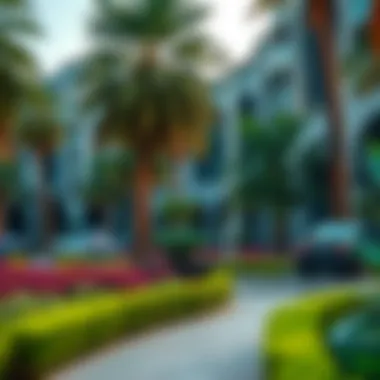
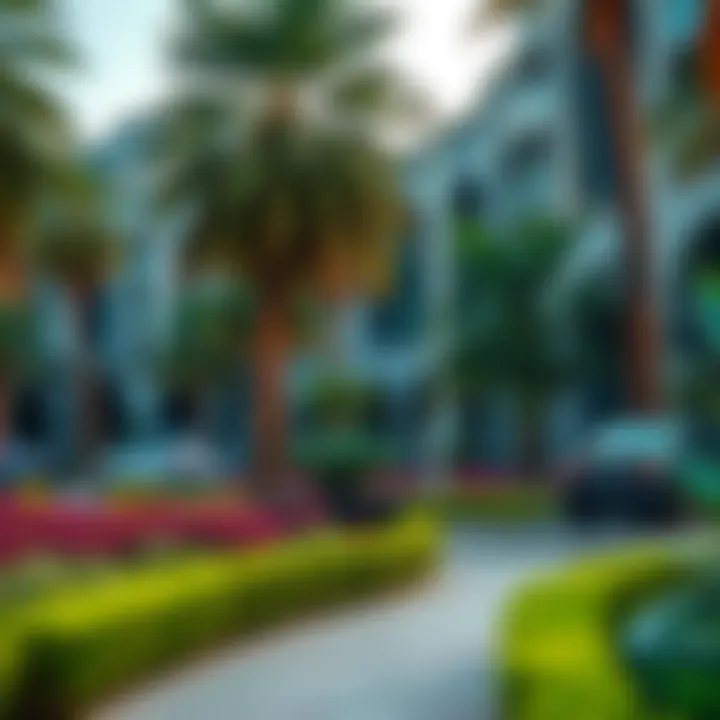
Real Estate Trends
The real estate trends in Al Nasr and Oud Metha are reflective of broader market movements within Dubai. Recently, the area has seen a surge in property demand. Factors such as proximity to key business centers, schools, and recreational facilities contribute positively to market dynamics.
- Price Fluctuations: Home prices have varied, with some fluctuations driven by supply and demand dynamics. It's wise to keep an eye on the market, as certain times of year may yield better deals.
- Investment Opportunities: Investors are increasingly looking at these neighborhoods due to their strategic location. Areas near Al Nasr and Oud Metha are often viewed as "up-and-coming," making property investments appealing.
- Sustainability Trends: The current push toward eco-friendly developments has prompted many contractors to incorporate sustainable materials and practices. This is seen in new constructions that often seek to optimize energy efficiency and reduce environmental impact.
As Al Nasr and Oud Metha embrace change, they continue to balance their historical roots with modern demands in residential living. For anyone considering a move or investment here, understanding these trends and the types of housing available provides a clearer picture of what’s at stake.
"The residential landscape is not just about buildings; it's about the community's way of life. A strong sense of place holds communities together, and understanding housing types reflects that collective identity."
Navigating the residential offerings and trends can greatly influence one's lifestyle and financial decisions within these neighborhoods.
Community and Social Life
Understanding the community and social landscape of Al Nasr and Oud Metha reveals much about the fabric that holds these neighborhoods together. This aspect significantly influences not only how residents interact but also shapes the identity of the areas themselves. A vibrant community life is essential because it fosters a sense of belonging, encourages participation, and enhances quality of life. The dynamics within communities reflect the shared values and cultural nuances that define Al Nasr and Oud Metha, providing a backdrop against which urban living can unfold.
Demographics and Population
The demographic profile of Al Nasr and Oud Metha is a tapestry woven from diverse backgrounds. Predominantly, you'll find a mix of expatriates and Emirati nationals, each bringing unique traditions and perspectives. As of recent population statistics, a significant portion of residents are South Asian, followed by those from Western and Middle Eastern countries. This mix creates a melting pot of cultures, which is both enriching and enlightening.
Current trends show a growing population, partly due to the ongoing development in related sectors, including utilities, education, and commercial establishments. This influx can lead to fluctuations in community dynamics as new residents mingle with long-standing inhabitants. Understanding these demographics helps planners and social organizers design programs and facilities that cater to a wide array of interests and needs, ensuring inclusivity and engagement across the board.
Community Engagement and Events
Community engagement acts as the heartbeat of Al Nasr and Oud Metha. It’s about more than just mere gatherings; it’s about sowing the seeds of connection among residents. The neighborhoods host a variety of events that cater to all ages and interests. From cultural festivals celebrating the rich traditions of the region to more contemporary gatherings like food fairs, these events are crucial for building rapport among residents.
- Annual Events: Celebrations such as the Dubai Shopping Festival and Eid festivities draw crowds from all over and encourage participation from locals and visitors alike.
- Workshops and Classes: Various community centers regularly offer classes ranging from cooking to art, providing avenues for learning while connecting with fellow residents.
"Community events not only build friendships but also strengthen the social fabric of our neighborhoods. They are the place where memories are created and shared among people."
Social Infrastructure
The social infrastructure in Al Nasr and Oud Metha is thoughtfully designed to serve diverse populations. It comprises various facilities, including schools, healthcare centers, and recreational spaces, underpinning the essence of communal life.
- Educational Institutions: Numerous schools and educational centers cater to different curricula, thus meeting the needs of families from varying backgrounds.
- Healthcare Facilities: Access to clinics and hospitals fosters a sense of security among the residents, knowing they can receive quality care nearby.
- Recreational Spaces: Parks and leisure areas provide vital spaces for families and friends to gather, stay active, and enjoy leisure time.
Engagement with this social infrastructure not only enhances daily lives but also creates connections, ultimately enriching the community as a whole.
Here, Al Nasr and Oud Metha demonstrate that community and social life are not merely supportive elements; they are foundational to the vibrancy and sustainability of these neighborhoods.
Landscape and Green Spaces
The neighborhoods of Al Nasr and Oud Metha are often celebrated not merely for their architectural nuances or bustling community life but significantly for their integration of natural landscapes and green spaces. These areas, amidst the urban sprawl of Dubai, play a key role in enhancing the quality of life for residents, providing essential relief and recreational opportunities. Green spaces are not just patches of grass; they are vital sanctuaries that promote mental wellness, encourage community engagement, and foster ecological balance.
Parks and Recreational Areas
Within Al Nasr and Oud Metha, parks stand as the lungs of the community. For instance, the well-frequented Al Nasr Park offers ample room for families to unwind and enjoy nature. With walking paths, children’s play zones, and picnic areas, it serves as a popular destination for both younger families and older residents seeking leisurely strolls. The availability of amenities encourages active lifestyles and community interactions.
Moreover, Oud Metha showcases a variety of smaller recreational areas that cater to diverse interests, ranging from fitness yards to tranquil gardens. These spaces are precious, especially in the relentless heat of Dubai, where shade and greenery become much-desired retreats.
"Investing in parks is investing in the soul of the community."
Urban Green Initiatives
In recent years, the local government and community organizations have undertaken various urban green initiatives tailored to enhance the livability of Al Nasr and Oud Metha. The focus has shifted towards sustainability with the implementation of programs aimed at increasing green cover. Urban farming strategies are popping up, allowing residents to engage in community gardening, which not only beautifies the space but also promotes local food production.
Additionally, initiatives such as planting campaigns and awareness programs about biodiversity have emerged. These seek to engage local schools, neighborhoods, and excited volunteers, collectively contributing to a greener urban environment. There is an understanding that urban green spaces do more than beautify; they play a crucial role in mitigating urban heat, improving air quality, and enhancing biodiversity.
- Benefits of urban green initiatives include:
- Increased community cohesion
- Improved environmental health
- Enhanced property values
- Promotion of active lifestyles
In sum, landscape and green spaces in Al Nasr and Oud Metha are more than aesthetic additions; they are essential components of urban life that bring people together while nurturing health and harmony within the bustling metropolis of Dubai.
Cultural and Educational Institutions
In the vibrant tapestry that is Al Nasr and Oud Metha, cultural and educational institutions play a pivotal role, acting as the backbone of community engagement and intellectual advancement. These facilities are not merely places of learning and cultural exchange but also serve as hubs where diverse people can connect and collaborate. In a city as dynamic as Dubai, understanding the significance of these institutions enhances our appreciation of the neighborhoods and supports their continuous growth and vibrancy.
Schools and Universities
In the realm of education, Al Nasr and Oud Metha boast a variety of schools and universities that cater to both local and expatriate populations. Some of the notable educational facilities include
- The International School of Arts and Sciences
- American School of Dubai
- Wellington International School
These institutions are not only focused on academic excellence but also prioritize holistic development. Schools in these areas incorporate innovative teaching methodologies that go beyond textbooks, encouraging critical thinking and creativity. This approach is reflected in the extracurricular programs and international qualifications offered, which appeal to families seeking a well-rounded education for their children.
The presence of higher education institutions further enriches the educational landscape.
University of Dubai and Middlesex University Dubai are just a couple of examples where higher learning is accessible. These universities provide a multitude of programs that are designed to meet the needs of a rapidly evolving job market, positioning students for success in various industries.
Cultural Centers and Libraries
Cultural centers and libraries in Al Nasr and Oud Metha serve as vital components for the community, acting as reservoirs of knowledge and cultural heritage. Places like the Dubai Public Library located in Al Nasr offer a vast array of resources ranging from literature to digital media. These libraries have made contributions by hosting various events that encourage people to engage with literature and art. It not only serves individuals seeking knowledge but also acts as a meeting point for book clubs, workshops, and lectures.
Cultural centers such as the Cultural and Scientific Association offer programs aimed at preserving and promoting Arabic culture. They provide workshops, art exhibits, and lectures designed to showcase the rich history and traditions of the region.
"The heart of a community thrives when its culture is celebrated and preserved."
Investing in these institutions not only cultivates a strong sense of community but also empowers individuals to connect with their roots while embracing a global perspective.
By examining these aspects of Al Nasr and Oud Metha, it becomes clear that cultural and educational institutions are more than just buildings; they are integral to shaping the identity and future of these neighborhoods.
Economic Landscape
The economic landscape of Al Nasr and Oud Metha plays a fundamental role in shaping the identities of these neighborhoods. This section delves into the local businesses, employment opportunities, and commercial developments that contribute to their vibrancy. Understanding the economic dynamics here not only helps residents and potential investors gauge the viability of these areas but also highlights the role local entrepreneurs play in fostering community engagement and growth.
Local Businesses and Employment
Al Nasr and Oud Metha are bustling with a myriad of local businesses, ranging from cozy eateries to retail shops. This diversity allows residents to support their community while having access to goods and services without having to venture far.
- Many small shops flourished, reflecting a commitment to maintaining local culture and individuality.
- Restaurant chains sit alongside hidden gems where recipes are passed down through generations, creating a culinary scene that attracts food lovers.
Employment in these neighborhoods is largely rooted in small and medium-sized enterprises. These businesses not only provide job opportunities but also contribute significantly to the economic stability of the area. For instance, local establishments create a ripple effect; as more businesses open, they generate new roles in hospitality, retail, and management. “Each small business can serve as a pillar for local employment,” explains Ahmed, a resident and small shop owner.
Such environments cultivate a sense of place, where people can enjoy direct interaction with business owners and services tailored to their needs. Local ventures, such as coffee shops or boutique stores, frequently engage the community through events such as pop-up markets, which reinforce local ties and foster economic resilience.
Commercial Developments
The landscape of commerce in Al Nasr and Oud Metha is ever-evolving, marked by both traditional and modern commercial developments. The architecture reflects this transformation, with newly built shopping centers standing alongside established markets. This blend offers a unique shopping experience.
- Prominent Centers: Among the marquee shopping venues is the Oasis Center, which acts as a magnet for shoppers seeking everything from clothing to electronics.
- Cultural Hub: Simultaneously, the area indulges in the nostalgia of traditional souks, where local artisans sell handcrafted items, thus preserving cultural heritage.
These developments are not just about retail; they also bring in eateries, entertainment options, and fitness centers. Such an approach enhances accessibility and meets the diverse needs of the community.
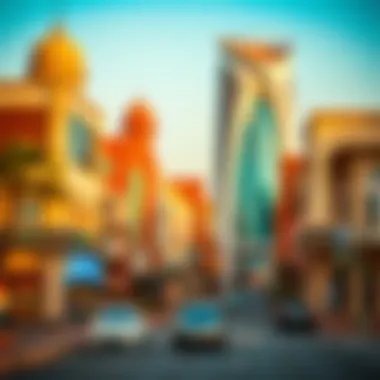
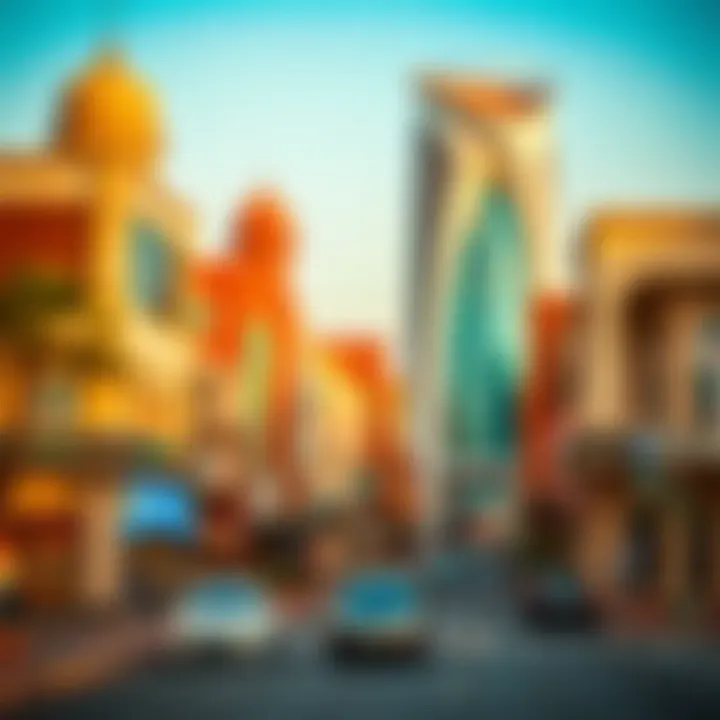
The ongoing commercial projects indicate a forward-thinking attitude among investors and local authorities, leaning towards creating spaces that are not only functional but also enjoyable to explore.
“Investing in this area is not just about profit; it’s about cultivating a neighborhood that people love to live and work in,” shares Sarah, an urban planner closely following the area’s developments.
Transportation and Connectivity
The neighborhoods of Al Nasr and Oud Metha play a crucial role in the overall connectivity of Dubai. Effective transportation systems not only enhance the accessibility of these communities but also contribute to economic growth and social interaction. These areas benefit from a variety of public and private transport methods, each designed to cater to different needs and preferences. Understanding how individuals traverse these regions can offer insights into their livability and appeal.
Public Transit Options
Dubai's public transit system is notably efficient and user-friendly, making it quite easy for residents and visitors to get around. The public transport options available in these areas primarily include the Dubai Metro, buses, and taxis.
- Dubai Metro: The closest metro station to Oud Metha is the Oud Metha Metro Station, which lies on the Green Line. For Al Nasr, the nearest station is also within walking distance, linking these neighborhoods effectively to other parts of Dubai. The metro is not only fast but also affordable, making it a popular choice among daily commuters. It’s especially beneficial for those working in commercial centers, as it reduces the stress of traffic congestion.
- Buses: The network of buses is extensive in Dubai, and routes frequently travel through Al Nasr and Oud Metha. This option is more flexible, allowing travelers to reach areas that may not be directly served by the metro. Regular schedules ensure that the buses are a reliable choice, whether for short trips or longer journeys.
- Taxis and Rideshares: For those needing a more direct and personalized mode of transport, taxis are readily available. Additionally, rideshare services like Careem and Uber have seen widoespread use here. They provide door-to-door service, adding convenience.
Road Infrastructure
The road infrastructure surrounding Al Nasr and Oud Metha is well-developed, reflecting the urban planning efforts of Dubai. This not only eases day-to-day transport but also supports the bustling lifestyle of its residents.
- Major Roads: Key roads such as Khalid Bin Al Waleed Road and Al Mina Street run through these neighborhoods, connecting them to the heart of the city and beyond. This connectivity fosters economic and social activities, as it enables residents to access essential services and leisure activities without much hassle.
- Traffic Management: Local authorities have implemented various traffic management systems to mitigate congestion during peak hours. This includes traffic lights equipped with smart technology that adapts to flow patterns, ensuring smoother journeys.
- Parking Facilities: Ample parking space is available in commercial and residential zones, particularly around popular shopping centers and public transit stations. This is a vital aspect of urban life in Dubai, where the vehicle ownership rate is high.
"The effectiveness of a city’s transit system is a key ingredient to development. It reflects the balance between modernity and accessibility, making places livable and vibrant."
For more on Dubai's public transport system, visit Dubai RTA or check out details on Wikipedia's Dubai Transport.
Understanding these facets of transportation is significant, particularly for homeowners, visitors, and urban planners who wish to grasp the rhythm of life in Al Nasr and Oud Metha.
Future Prospects and Developments
The neighborhoods of Al Nasr and Oud Metha are not just historical and cultural hubs; they are evolving landscapes that reflect the pulse of modern urban living. The significance of discussing future prospects and developments is essential, as these factors can significantly shape the lifestyles of residents and the overall community environment. By examining urban planning initiatives and anticipating demographic changes, we gain insight into how these areas might evolve.
Urban Planning Initiatives
Urban planning in Al Nasr and Oud Metha is a response to the growing needs of the populace. Here, local governments and planners are taking thoughtful strides toward creating sustainable and functional urban spaces. One noteworthy initiative involves the enhancement of public transportation systems that aim to reduce traffic congestion and make it easier for residents to navigate around the city.
Additionally, the integration of green spaces is becoming more pronounced. Recent plans include expanding parks and community gardens to promote an eco-friendly lifestyle and invigorate community ties. Planners are also focusing on mixed-use developments where residential, commercial, and recreational spaces blend seamlessly together. This philosophy not only optimizes land use but also enriches neighborhood dynamics.
Some of the key aspects of urban planning initiatives include:
- Creation of pedestrian-friendly walkways.
- Development of bike lanes to encourage sustainable transportation.
- Revamping public facilities, like libraries and community centers, to align with modern needs.
As these initiatives come to fruition, Al Nasr and Oud Metha are on track to become even more vibrant and interconnected communities.
Anticipated Changes in Demographics
Demographics are a clear indicator of how a community's character can shift over time. In Al Nasr and Oud Metha, anticipated changes in demographics are shaped by inflows of expatriates and young professionals drawn to the dynamic job market of Dubai. This influx could lead to a more diverse population with varying cultural backgrounds and lifestyles.
Moreover, with families seeking residences that provide quality schooling and recreational activities, it is likely that the areas may see an uptick in family-oriented developments. Planners and community leaders will have to consider these factors to ensure facilities cater to these changing needs while maintaining the area’s historical essence.
Here are a few anticipated demographic shifts expected in the coming years:
- An increase in younger families opting for these neighborhoods as their preferred living choice.
- A growing trend of remote workers choosing to settle in the area given its accessibility and amenities.
- Shifting cultural priorities leading to more mixed-community programs and events that reflect the variety of the populace.
"The future of Al Nasr and Oud Metha is not just in its buildings; it's in its people and how they come together to shape the community."
The challenges and opportunities that arise from these demographic shifts will shape the fabric of both neighborhoods, making this a point of critical importance for homeowners, planners, and architects who envision the future of urban living. As Al Nasr and Oud Metha continue to transform, understanding these factors becomes essential for fostering a cohesive community.
Dining and Shopping Experiences
Dining and shopping experiences play a pivotal role in shaping the cultural and social dynamics of any neighborhood. In Al Nasr and Oud Metha, these experiences are not just essential for daily living; they serve as a microcosm of the community's identity. Here, individuals and families come together to indulge in diverse culinary delights and explore vibrant markets. These interactions create a vibrant social fabric, inviting newcomers and long-standing residents alike to engage in community life.
The culinary scene, accentuated by the unique blend of local and international flavors, offers something for everyone. Whether one is after glitzy dining establishments or hidden gems, the options abound. Additionally, the shopping venues provide an abundance of choices, from high-end boutiques to bustling markets. This section will delve into what makes the dining and shopping experiences in Al Nasr and Oud Metha special.
Local Eateries and Cafés
One can easily get lost in the gastronomical landscape of Al Nasr and Oud Metha. The local eateries and cafés, from traditional Arabian spots to the new eclectic joints, tell stories of the neighborhoods' rich history through their menus.
- Traditional Delicacies: Local favorites can often be found, like shawarma joints and falafel stands, which grace the sidewalks. Eating some hummus at a small place while sipping Arabic coffee can transport diners to another era.
- Contemporary Choices: Beyond local food, international cuisines provide a broader palate. An Indian restaurant offering authentic biryani or a cozy Italian trattoria can be your go-to, depending on your mood.
Some noteworthy places to try include:
- Al Nasr Restaurant - Famous for its grilled meats and a warm setting.
- Kris Kros Café - Known for its inventive brunches and inviting atmosphere.
- Times Square Café - A popular spot for local pastries and rich coffee blends.
In a city bustling like Dubai, discover moments in the quaint corners of these local spots. They are not just places to eat, but spaces to connect with friends and family.
Shopping Venues and Markets
When it comes to shopping, Al Nasr and Oud Metha do not disappoint. The local markets and shopping centers make them a hub for residents and visitors to find everything they need.
- Vibrant Local Markets: Markets scattered throughout the neighborhoods brim with life. Vendors showcase fresh produce, local handicrafts, and textiles that can often be haggled for a better price. A visit to these markets provides valuable insight into the daily lives of those who live here.
- Shopping Malls: On the more commercial side, shopping malls in these areas offer a mix of global and regional brands. Retailers range from high-end fashion to everyday needs within a comfortable climate-controlled space.
Prominent shopping spots include:
- Al Nasr Market - Hosts a variety of small shops and eateries, all within a vibrant community atmosphere.
- Oud Metha Mall - Offers a traditional shopping experience with a blend of local and international brands.
These venues not only facilitate shopping but also act as meeting points where individuals can forge connections and experience the community in a lively setting.
"A neighborhood thrives when its people dine and shop together, fostering connections and creating memories."
In summary, the dining and shopping experiences in Al Nasr and Oud Metha encapsulate the essence of Dubai's cultural blend. Patrons and enthusiasts find joy in the rich variety and quality offered. These experiences elevate the neighborhoods, making them not just places to live but vibrant, community-centered environments.
Health and Wellness Facilities
In an urban environment like Dubai, the importance of health and wellness facilities cannot be overstated. They serve as cornerstone institutions that cater to both the physical and mental well-being of residents and visitors. Al Nasr and Oud Metha are no exception, offering a range of services that contribute significantly to the community’s health and lifestyle.
Hospitals and Clinics
Health care facilities in Al Nasr and Oud Metha are generally well-equipped and accessible. A mix of public and private hospitals provides a variety of services tailored to meet diverse needs.
- Public Hospitals: These tend to be more affordable options and are known for their comprehensive care. Facilities like Rashid Hospital offer emergency services and specialized treatments.
- Private Clinics: On the other hand, provide personalized services with shorter waiting times. Clinics such as Dubai London Clinic in Oud Metha focus on individual care and often have specialists in fields ranging from pediatrics to dermatology.
Research shows that easy access to hospitals and clinics enhances community health. Regular check-ups, vaccinations, and preventive measures support a healthier population. It’s essential that these facilities are not just reactive but proactive, encouraging individuals to invest in their health.
Additionally, many hospitals in these neighborhoods offer wellness programs and health education sessions that focus on nutrition, exercise, and chronic disease management.
Fitness Centers and Spas
Beyond hospitals and clinics, the fitness scene in Al Nasr and Oud Metha also stands out. Numerous fitness centers and spas create spaces where individuals can pursue their fitness goals while also indulging in relaxation and self-care.
- Fitness Centers: These offer everything from traditional gym equipment to group classes that engage various fitness levels. Local favorites like Fitness First and Gold's Gym are frequented by residents. Various classes are also essential, catering to different interests—including yoga, Pilates, and high-intensity interval training.
- Spas: Spa facilities, such as The White Room Spa in Oud Metha, provide a haven for relaxation, combining wellness with indulgence. Services often include massages, facials, and other treatments aimed at rejuvenating both body and spirit.
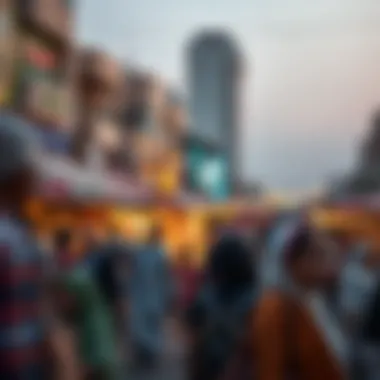
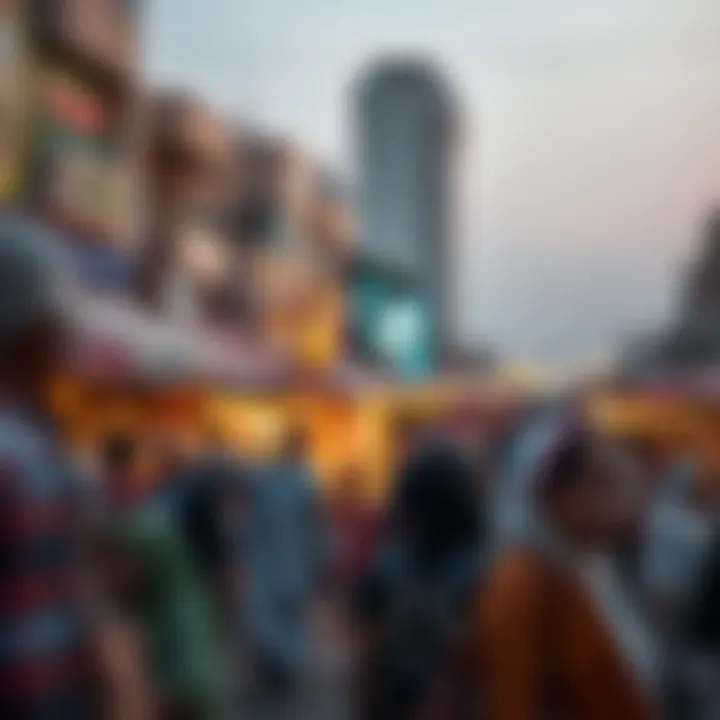
Incorporating both fitness and wellness into daily life has shown to increase overall happiness and life satisfaction. The blend of activity and relaxation available in these areas ensures that health is not solely about treating ailments but also about enhancing quality of life.
"Health is not merely the absence of disease, but a state of complete physical, mental, and social well-being."
In summary, the health and wellness facilities in Al Nasr and Oud Metha play a pivotal role in shaping an enriching lifestyle for the community. Accessible hospitals and diverse fitness centers contribute to a holistic approach to health, making the neighborhoods nurturing environments for all.
Art and Cultural Expression
Art and cultural expression play a pivotal role in shaping the identity of Al Nasr and Oud Metha. These two neighborhoods in Dubai are not merely characterized by their architectural beauty and bustling streets; they are vibrant canvases that reflect the diverse narratives and rich traditions of their residents. Emphasizing the importance of art can foster community pride, promote tourism, and enhance social interactions amidst the multicultural backdrop of Dubai.
In this article, we delve into the unique art and cultural offerings found in Al Nasr and Oud Metha, which include various forms of public art projects and cultural festivals. Through these expressions, the neighborhoods reveal layers of meaning and connections to both local and global narratives, creating a richer experience for visitors and residents alike.
Public Art Projects
Public art projects in Al Nasr and Oud Metha serve as a connection between the past and present, offering a glimpse into the soul of these communities. These creative endeavors aren't just aesthetics; they often address social issues or reflect the history and heritage of the region. For instance:
- Murals: Large-scale murals on building facades showcase local artists and their interpretations of Emirati culture, often inviting onlookers to appreciate art in a way that is interactive.
- Sculptures: Public installations can be seen in parks and open spaces, intended to spark conversation and contemplation among passersby. They invite interaction, making art accessible to those who may not traditionally engage with it.
- Art Workshops: Collaborative projects involving community members allow for shared experiences, fostering creativity and connection among people of all ages.
"Art is not what you see, but what you make others see." – Edgar Degas
These elements of public art breathe life into the neighborhoods, transforming ordinary spaces into extraordinary experiences, and engendering a sense of belonging among locals. The impact of these artistic expressions is profound, encouraging cultural dialogue while enriching the urban landscape.
Cultural Festivals
Cultural festivals in Al Nasr and Oud Metha not only showcase the rich tapestry of traditions and customs but also serve as a platform for celebration and unity. These events highlight the diversity of the community, with activities ranging from traditional dance performances to food fairs. Here are a few noteworthy aspects of these festivals:
- Diversity: Celebrations often feature music and dance from various cultures, helping to break down barriers and foster an atmosphere of acceptance.
- Traditions: Throughout the year, various festivals honor significant cultural events, providing residents with the opportunity to participate in traditional customs, rituals, and cuisine. This helps to keep heritage alive in a rapidly changing urban landscape.
- Community Engagement: Many festivals encourage local businesses to participate, giving them a platform to showcase their products and contributing to the local economy.
In sum, art and cultural expression serve as essential threads woven into the fabric of Al Nasr and Oud Metha, enriching the lives of those who inhabit or visit these neighborhoods. By celebrating and maintaining their cultural heritage, these areas become a unique representation of Dubai’s evolving identity.
Local Attractions and Landmarks
Understanding the local attractions and landmarks of Al Nasr and Oud Metha is crucial for appreciating the essence of these areas. Within these neighborhoods lies a rich blend of history and modernity, creating a vibrant tapestry that reflects the culture and life of Dubai. Local attractions serve not only as recreational spots but also as venues for community engagement, drawing residents and visitors alike into a shared space where relationships are built and memories made.
Historical Buildings
Historical buildings in Al Nasr and Oud Metha act as portals to the past. These structures carry stories of the region's development, showcasing architectural styles that have evolved alongside the city itself. For instance, you can stumble upon buildings that date back to the early days of Dubai’s modernization. Their facades may be unassuming, yet they breathe life into the streets through their mere presence.
- Al Nasr Cultural Center: This center is a fine example of traditional architecture, all while serving as a hub for cultural activities and exhibitions. Its walls echo the voices of many artists and performers who have graced its stage over the years.
- Sheikh Rashid's House: Once a home to one of Dubai’s notable rulers, this building embodies a simple yet elegant design that contrasts sharply with the sleek modernity surrounding it today. Visitors often find themselves captivated by its serene gardens, which provide a respite from the bustling city around.
Historical sites like these foster a connection between generations, allowing the community to reflect on its roots while embracing new developments. The juxtaposition of the old against the new fosters a unique identity, making these areas stand out within Dubai's fast-paced growth.
Modern Architectural Highlights
In stark contrast to the historical buildings, modern architectural highlights in Al Nasr and Oud Metha paint a different picture of the neighborhoods. These structures illustrate the ambitious spirit of Dubai, aiming for the sky while paving new paths for innovation and sustainability.
- Al Nasr Plaza: With its blend of retail spaces and contemporary design, Al Nasr Plaza is a showcase of how modern shopping experiences have evolved. It is not just a shopping destination but a lifestyle hub that includes everything from chic cafes to entertainment options.
- The Loft Towers: A marvel of modern architecture, these towers symbolize the progressive outlook of the area. Offering luxury living arrangements along with panoramic views of the cityscape, they stand tall as a testament to evolving urban living standards.
The integration of modern design elements with functional living spaces enhances the overall aesthetic of the neighborhoods, attracting both homeowners and investors.
Both historical sites and modern architecture provide essential insights into the dual character of Al Nasr and Oud Metha. When combined, they encapsulate the journey of Dubai, embracing its heritage while gracefully advancing towards the future. This blend of old and new makes the neighborhoods dynamic places to explore, offering a little something for everyone.
Environmental Considerations
Environmental considerations play a pivotal role in enhancing the quality of life and ensuring a sustainable future for communities like Al Nasr and Oud Metha. In urban areas such as these, thoughtful attention to environmental factors is crucial, particularly in light of rapid urbanization and climate change. Residents and local authorities alike must be aware of the impact their choices make on the ecosystem. The emphasis on sustainability practices and green building initiatives can benefit both the community and the environment.
The importance of focusing on environmental considerations cannot be understated. By integrating sustainability into the core of urban planning, Al Nasr and Oud Metha can preserve their natural heritage while fostering a vibrant community atmosphere. This not only aids in the conservation of resources but also enhances property values, as homes in sustainable neighborhoods often attract more interest from prospective buyers and renters. Aesthetically pleasing green spaces further contribute to community identity and engagement.
Sustainability Practices
Sustainability practices in Al Nasr and Oud Metha are increasingly coming to the forefront, addressing both environmental and social dimensions. Research has shown that promoting eco-friendly practices can lead to significant benefits, including reduced costs and improved community well-being.
One notable initiative is the promotion of community gardens. These small plots of land allow residents to grow their own fruits and vegetables, encourage local biodiversity, and provide a connection to nature in densely populated urban areas. Community gardening not only contributes to healthier eating habits but also strengthens social ties among neighbors.
Another important aspect is the encouragement of waste separation and recycling programs. Implementing effective recycling systems can lead to reduced landfill waste and promote a culture of sustainability.
Benefits of Sustainability Practices:
- Cost Efficiency: Community gardens can reduce grocery bills.
- Social Connections: Engaging in local gardening promotes friendships and a sense of belonging.
- Waste Management: Recycling initiatives minimize environmental impact.
Green Building Initiatives
Green building initiatives are essential in shaping the future of Al Nasr and Oud Metha. These approaches not only reduce the carbon footprint but also promote energy efficiency, which ultimately leads to cost savings for homeowners.
For instance, the implementation of energy-efficient building materials can greatly decrease energy consumption. This might include utilizing solar panels, which harness renewable energy from the sun, or installing energy-efficient windows that minimize heat loss during the cooler months.
Additionally, the use of sustainable water practices, such as rainwater harvesting systems, signifies a proactive step towards water conservation. Such initiatives not only meet the practical needs of the present but also safeguard resources for future generations.
"Integrating green building techniques is not just about creating structures but nurturing a sustainable lifestyle for the entire community."
Key Aspects of Green Building Initiatives:
- Materials: Eco-friendly construction materials.
- Energy Sources: Solar panels and other renewable energy solutions.
- Water Management: Implementation of rainwater harvesting.
By embracing these practices and initiatives, the communities of Al Nasr and Oud Metha are not only addressing current environmental issues but are also setting a benchmark for sustainable living in the region. Creating a balance between urban development and ecological preservation is essential for ensuring that these areas remain livable, vibrant spaces for all.
Challenges and Opportunities
Exploring the challenges and opportunities within Al Nasr and Oud Metha presents a vital component in understanding the evolving landscape of these neighborhoods. As these areas continue to grow and develop, acknowledging the obstacles they face is crucial for homeowners, visitors, and urban planners. At the same time, identifying potential opportunities can provide a roadmap for future developments, creating a balanced and sustainable environment that benefits all stakeholders.
Urban Challenges Facing the Areas
Despite the vibrant community atmosphere and historical significance, Al Nasr and Oud Metha are not without their urban challenges.
- Traffic Congestion: One of the most pressing issues is traffic density, especially during peak hours. The intertwining roads can make commuting cumbersome.
- Infrastructure Limitations: Aging infrastructure can hinder the quality of life, as some local roads and facilities may not accommodate the increasing population. This can affect everything from waste management to public services.
- Population Growth: The neighborhoods are undergoing a demographic shift, with a surge in residents leading to a strain on local amenities. Schools and healthcare facilities may become overcrowded, creating further issues for existing residents.
"While challenges are abundant, they also serve as opportunities for innovation and renewal."
Opportunities for Growth and Development
On the flip side, Al Nasr and Oud Metha offer considerable opportunities for enhancement and progress:
- Urban Redevelopment Projects: Local authorities have initiated redevelopment plans aimed at modernizing neighborhoods and boosting economic activity. This includes refurbishing existing buildings and constructing new mixed-use spaces.
- Cultural Festivals: The rich heritage of the area can be leveraged through cultural events that attract visitors and foster community spirit. Festivals provide platforms for local artists and businesses, hence boosting the local economy.
- Sustainability Initiatives: As the focus shifts towards environmental consciousness, opportunities abound for incorporating green technologies and eco-friendly practices in building designs. Green spaces can enhance the livability of the area, appealing to both residents and potential investors.
Recognizing these challenges and opportunities can fundamentally shape the future of Al Nasr and Oud Metha. By addressing the obstacles and capitalizing on available opportunities, stakeholders can help create a more sustainable and vibrant community.
End
In reviewing the unique characteristics of Al Nasr and Oud Metha, this article illustrates the vital role these neighborhoods play in the urban landscape of Dubai. These areas not only reflect the rich cultural tapestry of the city but also harbor opportunities for social interaction, economic growth, and community development. They are seen as a microcosm of Dubai’s evolution, showcasing how traditional roots merge with modern aspirations.
Understanding the nuances of Al Nasr and Oud Metha is crucial for homeowners, visitors, city planners, and architects. These insights offer a more profound appreciation of the vibrancy and diversity that characterize the socio-economic dynamics here. For instance, the local businesses and commercial developments underscore an entrepreneurial spirit that thrives amidst community engagement.
The conclusion also invites readers to reflect on how these neighborhoods continue to adapt in the face of urban challenges, all while ensuring sustainability and green initiatives. The infusion of parks and recreational spaces demonstrates a commitment to enhancing quality of life. Moving forward, stakeholders can harness this understanding to foster developments that resonate with both the spirit of the community and the practicalities of modern living.
"Al Nasr and Oud Metha embody a blend of history and progress that is essential in crafting a vision for the future of Dubai."
Ultimately, the exploration provided in this article serves as a foundational understanding of not just Al Nasr and Oud Metha, but as a lens through which one can view the ever-evolving identity of Dubai itself. As these neighborhoods progress, they hold lessons and inspiration for similar urban environments across the globe.








